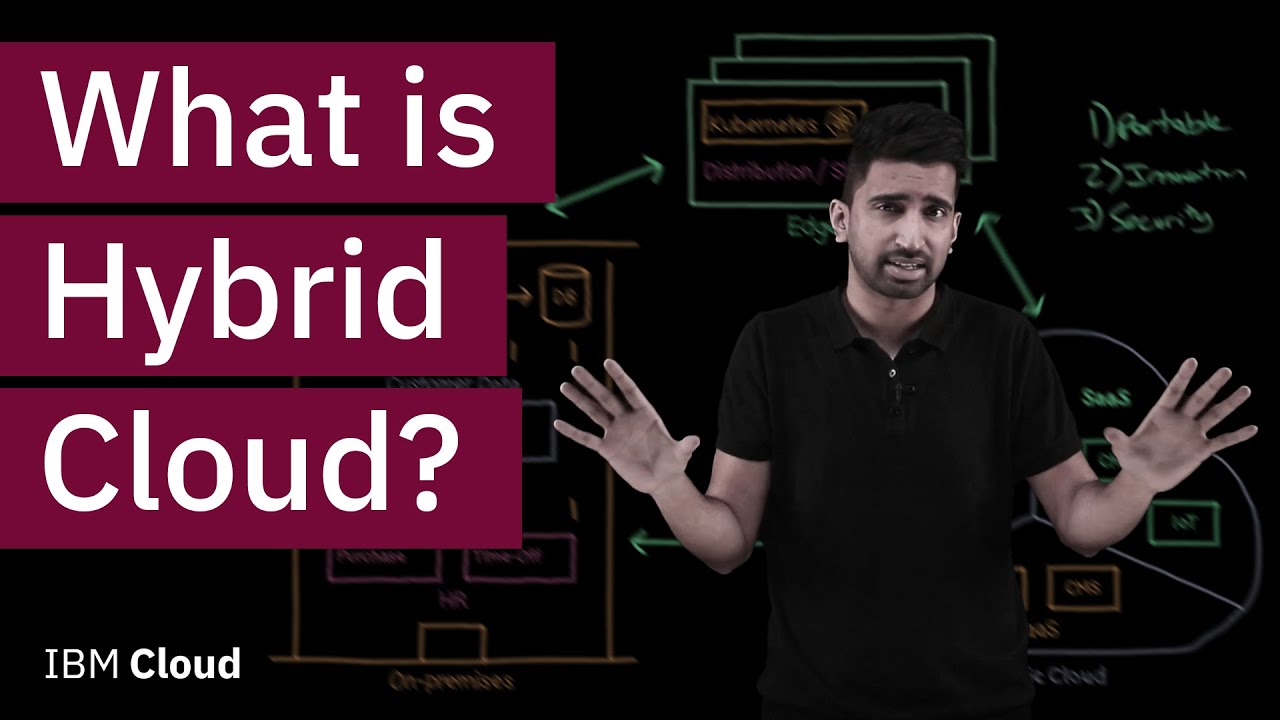In Cloud Consulting
What is Hybrid Cloud? - read the full article about cloud technology 2021, Cloud Consulting and Data migration, Cloud infrastructure management from IBM Technology on Qualified.One

Youtube Blogger

Hey everyone, today lets talk about hybrid cloud. Now by the book it refers to a cloud computing architecture with two or more environments consisting of public and private clouds, on-premises, and these days even edge environments. But without the right strategy, hybrid cloud can actually pose a number of challenges. Now today were going to go through an example to lay out some of those advantages and disadvantages of a fictional distribution company that started to undergo that hybrid cloud transformation process. Now were going to start with what they have kind of on-premises. Now right off the bat lets start with this legacy application that theyve got. Now this is an application that enables their users to get shipment and tracking information and it continues to work so they dont really have a good reason to modernize it, although it is kind of running on some legacy, old school, lets say Java EE based monolithic architecture. In addition, theyve also got some customer data thats running on-premises. Now this is one of the key advantages of hybrid cloud is it lets you run workloads where you need them. So in this particular case to comply with GDPR or maybe some other regulations they need to keep that data on-premises which is actually a pretty cool advantage of hybrid cloud that they can continue to do that. Now, theyve also got some HR software running on-premises, were going to call this BPMS, or business process management software, and this is going to allow their customers to do or rather their workforce to do things like requesting time off, or maybe you know doing some purchase work orders that kind of thing. So thats what theyve got on-prem. Now we mentioned that theyve started the hybrid cloud transformation, they started to take advantage of cloud native, so lets see what theyve done in the public cloud. Now weve distilled the cloud into kind of three major categories in the past, so Infrastructure as a Service, Platform as a Service, and Software as a Service. Now, lets start with PaaS and what theyve done here is theyve taken advantage of a Kubernetes, or container-based environment, maybe even something like managed OpenShift running in the cloud to create a new version of the same application we talked about before the one one that works for mobile users. So mobile backend as well as a database there that kind of works for mobile users to be able to get tracking and shipment information. But this led to an increased cost and support to maintain all those users, so they started to take advantage of another service available in the cloud. So heres where SaaS comes in. They took a chat bot and they built it into that application and that enables them to offset some of that increased support costs. In addition, lets say theyre also using some of the SaaS capabilities for IoT for their delivery drivers, maybe in their warehouses, their distribution centers, that kind of thing. So IoT is helping you know track the goods and maybe making sure theyre temperature controlled, that kind of thing. And finally, for IaaS, heres an environment that I think kind of benefits from lift and shift. So some of that business process management software that theyve got running on-prem. Maybe theyve migrated some of that software over to the cloud, and I think thats an excellent opportunity to start taking advantage of IaaS is by kind of doing that lift and shift, taking advantage of some of that software and moving it there. Maybe theyre also running some CMS systems like WordPress for content management and theyre running that as software on some VMs that are made available through the IaaS capabilities in the cloud. Now those two environments are integrated together because you know theyve got some shared data, obviously the web interface and the mobile backend were probably using a similar data source. Finally theyve also got edge environments, so these are going to be things like distribution centers. Theyre called edge environments because theyre at the edge, theyre where data is being created and these distribution centers basically enable the customer to do things like kind of run workloads right where the data is being created. So maybe something like Kubernetes, or again OpenShift, a distribution of Kubernetes to manage the edge workloads where data is really being created. And those are obviously going to be integrated to the on-premises and cloud environments to share data about shipments so their users are getting the latest and greatest information about you know where that shipment is. So this is where the the company is today and theyve run into a number of challenges. So number one, they have increased complexity. So as theyve gone from on-premises to the cloud and all these engine environments now they have kind of an increased number of environments, so their ops teams have to maintain that. In addition, they need a way to port assets from one environment to another. So, so far they havent necessarily run into any issues but theyre starting to build a chat bot into the mobile backend and say hey maybe we should start taking advantage of that on our web application as well. And theyre finding theyre not able to easily do that, their DevOps teams are struggling because their assets arent quite portable, maybe they have multiple vendors theyre working with there isnt that consistency. And the last concern Ill raise is security, more environments, higher surface area of attack, their security team has to kind of invest more resources to help maintain these solutions. So there is a solution to all of this and its taking on a unified and open hybrid cloud approach and thats going to start at the infrastructure layer that weve already talked about a little bit. So, that infrastructure layer is going to be things like the on-premises environment, on-premises environment, its going to be public and private cloud environments, as well as edge locations. But heres where the key piece kind of starts to kind of work out. So at the foundational layer they need to start building some standardization. So heres where they can start building in a consistent operating system. So, something like Linux, or RHEL, or Red Hat Enterprise Linux, is going to help here because their developers can work against a single operating system across these multiple environments. And I mentioned RHEL because that brings me to my next point here the platform layer.
And heres where theyre going to be running something like Kubernetes. Kubernetes is great because it gives you that consistent container based environment that works in any kind of location on-premises, edge, the cloud, but you can even take it a step further with OpenShift container platform which is going to give you that enterprise supported approach to containers, and again, its great because it runs anywhere. Finally, the key to all of this is the solutions. So this consistency and standardization enables customers to focus on standardized solutions across the board so this can be things like the apps that theyre developing, or the data that they need to manage, or even security solutions that theyre building across the board. And this is just scratching the surface theres other use cases here that Im not even diving into. Things like integration, managing these multiple cloud environments, automation, that kind of thing. But this standardized layer and platform enables them to focus on solutions that work across the board. Now this is going to lead to a number of advantages. Now the number one thing about hybrid cloud is that it needs to be portable. That means your workloads need to be able to move across environments. Now we mentioned theyve got a monolithic legacy application architecture on-prem, maybe they start pulling in OpenShift, or Kubernetes on-premises, start refactoring into microservices and cloud native based applications, and they start having containers for that web interface application. Now if they want to they can start porting those assets to the cloud and take advantage of the elasticity there to scale up and down on demand. Number two, its going to be faster innovation. Now with that portability their developers can now think in a new way they can build once and deploy anywhere. So that chatbot experience they built for the mobile backend theyre going to be able to readily port that to the on-premise experience to the web user interface experience, the legacy app if they modernize it to kind of container-based architecture. So thats one of the key advantages their developers are going to benefit from faster innovation, reduce time to value, faster go to market by taking advantage of the industrys best, you know DevOps and agile practices. So, thats a key part about a hybrid cloud is faster innovation. And finally, as we mentioned before on the security front with that standardized layer of that OpenShift or Kubernetes that container-based environment across the board. Youre going to have consistency for things like pushing out compliance policies to these multiple environments and thats going to be critical here to make sure you have that kind of secure and consistent approach across these multiple environments. Now in the interest of standardization and standardization across the board and having that kind of consistent layer. Imagine if you could handle all of these layers, right, infrastructure foundation and solutions all from a single say public cloud environment. That means extending the public cloud to not just on-premises environment but maybe even other clouds and the edge. Well thats when were starting to get into the concept of Distributed Cloud, so I urge you to check out my video on that. Now with Hybrid Cloud its going to be paramount that you take a unified and open approach to truly set yourself up for success. If you enjoyed this video, have any questions be sure to drop a like or comment below. Stay tuned and follow us for more videos like this in the future. Thank you.
IBM Technology: What is Hybrid Cloud? - Cloud Consulting

